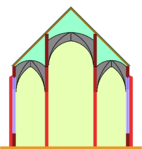Nave

As naves is called the longitudinal spaces of churches . If a church has several naves, these are separated from each other by partition walls with rows of arcades.
Designs
While hall churches have a single nave, churches often consist of several parallel parts of the room, called “ships”, which can have different widths and heights. A basilica is a church whose central nave is higher than the side aisles, with the central nave having its own windows in the upper aisle . A hall church, on the other hand, has naves of the same height, so that the central nave does not have its own window zone, as it does not tower above the neighboring naves. There are also intermediate types from these designs, such as the pseudo-basilica or relay hall, in which the naves are graduated in height, but do not have a window zone as in a real basilica. As a pilaster church is called Saalbauten where wall-bound pillars protrude from the walls here in the interior of the church so that arise along the side walls between the pillars individual parts of space. In the case of a central building , there is usually no talk of a ship.
Basilica , central nave with upper aisles (windows above the side aisles)
Pseudo basilica , central aisle vault above the aisle vault, but no ceilings
Relay hall , central nave a little higher, but not a whole floor
Hall church , all vaults the same height
Hall church with flat central nave ceiling and slightly inclined side nave ceilings
Single-aisle or hall church with a flat ceiling
Single-nave or hall church with barrel vaults and pillars
Nave church as Abseitensaal with clerestory above the side chapels
Central nave and side aisles
The nave or nave is the middle building and usually the widest, highest and longest of the church. This part is mostly intended for those attending the service . The nave Information provided by columns or pillars separate rooms, are as aisles and aisles or deprecated as Abseite referred. All of these structures together are also called the nave . The choir and transept of a church can also consist of several naves. The partition walls between the central nave and the aisles and between the side aisles are called partition walls , which are usually dissolved with arcades .
If the building plot allows, the nave is usually built in a west-east direction and the choir is oriented to the east - as a symbol of the New Sun or the resurrection of Christ . The semicircular end of the nave behind the choir is called the apse .
The second floor above aisles is called a gallery or grandstand .
Transept

The cross-ship or cross-house (also Transept ) denotes the extending in a perpendicular position to the nave shorter ship. This is usually created in front of the transition to the choir and thus forms a cross shape in the floor plan. Several transepts are also rarer, with the floor plan showing a cross with a corresponding number of transverse beams. At the Abbey Church of Cluny III there was a small and a large transept, a complex that is also common in the English Gothic. West transepts have only been built occasionally. The point where the nave and transept meet is called the crossing . In the exterior of the church, this point is often marked by a roof turret or a crossing tower. The two ends of the transept leading from the crossing are also called cross arms. In the basilicas of late antiquity and the early Middle Ages, the transept runs through as a separate room part and separates the nave from the apse. There is no crossing ( Roman transept ).
Tall ship
The nave is part of the central nave of the Basilica . It is located above the arcades in the area of the upper storeys .
Schematic representation
Word origin
The German dictionary of the Brothers Grimm leaves open whether it is about the metaphor ship (for example in the sense of the ark that saves from perdition ) or the early adoption of ancient Greek ναός or νεώς ( naós or ne „ s "temple, temple space") in the medieval Latin and its confusion with ancient Greek ναῦς ( naus "ship"). In any case, the Latin name navis ("ship") has been used for the central assembly room of the faithful in the church since the Middle Ages. In classical Latin it was not customary to designate an architectural space as navis ; however, the ship metaphor for the state and the civil society occurs more often in antiquity.
In the background of the idea of the church as a ship are two biblical stories, on the one hand the story of Peter's marvelous fishing trip ( Lk 5 : 1–11 EU ), on the other hand the story of Jesus' walk at sea and Peter sinking in the water ( Mt 14, 22-33 EU ).
The last-mentioned biblical story was taken up very early by Tertullian (born around 160 in Carthage, died after 220 ibid) in his work De Baptismo (chap. 12) and brought it together with the concept of the church. Alluding to the rescue of Peter, whose walk failed, he describes the little ship in which Jesus and his disciples sailed on the Sea of Galilee as a symbol of the Church.
Against the background of the persecution situation in the first centuries, this interpretation is obvious. Just as the ship that carries Jesus and his disciples is shaken by the waves and seems to be at the mercy of destruction, so it is in the first centuries of the Church, which suffered more and more from persecution and internal battles. It is assumed that Tertullian's interpretation of the story was also influenced by the hope that an event corresponding to the outcome of the biblical story might also occur in the future. As the troubled sea, obeying the words of Jesus, smooths out again, a state of peace between the Roman state and the Church should replace the situation of persecution.
See also
Web links
- Nave. In: relilex.de, accessed on October 8, 2016
Individual evidence
- ↑ definition of a nave on ekmd-online.de; accessed on August 27, 2018.
- ↑ See Hans Koepf : Bildverzeichnis der Architektur (= Kröner's pocket edition. Vol. 194). With English, French and Italian technical glossary. Revised by Günther Binding . 3. Edition. Kröner, Stuttgart 1999, ISBN 3-520-19403-1 , p. 406; 5th, through. and additional edition. Ibid 2016, ISBN 978-3-520-19405-3 .
- ^ German dictionary: Volume 15, columns 58 f. (sv SHIP No. 15).
- ↑ As well as English nave, Italian navata, French nef, Spanish and Portuguese nave
- ↑ For example, Cicero , Ad Familiares 12.25: una est iam navis bonorum omnium (“there is only one single ship for all decent people”).
- ↑ De Baptismo. Cape. 12 at Wikisource (Latin).
- ↑ Cf. Jochen Staebel: Navis Ecclesiae Militantis: To the ship allegory in the emanuelinischen architecture. In: Re-Visions. On the topicality of art history. Edited by Barbara Hüttel, Richard Hüttel, Jeanette Kohl. Walter de Gruyter, Berlin / Boston 2002, ISBN 3-05-007933-9 , pp. 77–96, here: p. 86, urn : nbn: de: 101: 1-201608272188 ( preview in Google book search).













